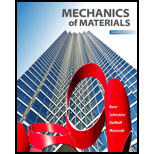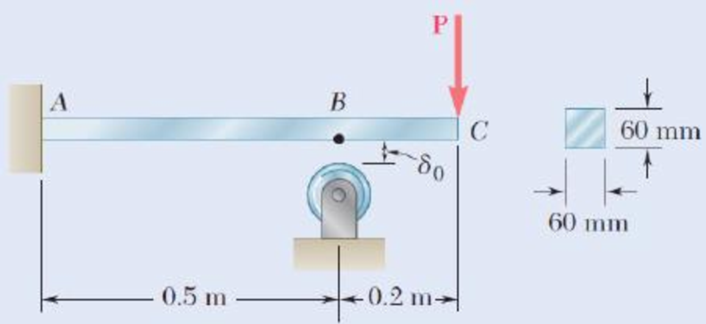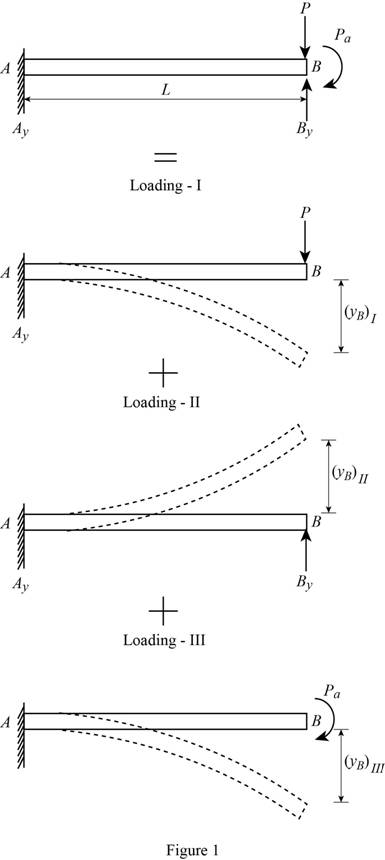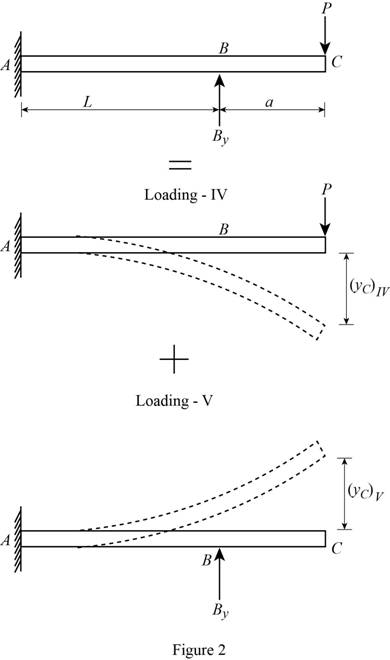
Concept explainers
Use the method of superposition to solve the following problems and assume that the flexural rigidity El of each beam is constant.
9.90 Before the load P was applied, a gap, δ0 = 0.5 mm, existed between the cantilever beam AC and the support at B. Knowing that E = 200 GPa, determine the magnitude of P for which the deflection at C is 1 mm.

Fig. P9.90
Find the magnitude of load P for the given condition using superposition method.
Answer to Problem 90P
The magnitude of load P in the beam is
Explanation of Solution
Given information:
The gap at the point B is
The modulus of elasticity of the material is
The size of the square cross section is
The deflection at point C is
Calculation:
Find the moment of inertia of the square cross section (I) using the relation.
Here, the size of the square cross section is a.
Substitute 60 mm for a.
Consider the portion AB of the beam.
The load P at point C will be converted into a load and moment at point B.
Show the free-body diagram of the superimposed beam AB as in Figure 1.

Loading I:
The downward load P is acting at point B of the beam.
Refer to Case 1 in Appendix D “Beam Deflections and Slopes” in the textbook.
Write the deflection equation for concentrated load acting in a cantilever beam as follows;
Find the deflection at point B due to load P at point B as follows;
Loading II:
The upward reaction
Refer to Case 1 in Appendix D “Beam Deflections and Slopes” in the textbook.
Write the deflection equation for concentrated load acting in a cantilever beam as follows;
Find the deflection at point B due to reaction at point B as follows;
Loading III:
The clockwise moment is acting at point B of the beam.
Refer to Case 3 in Appendix D “Beam Deflections and Slopes” in the textbook.
Write the deflection equation for moment in a cantilever beam as follows;
Find the deflection at point B due to the moment at point B as follows;
Find the resultant deflection at point B as follows.
Substitute
Substitute 0.5 mm for
Consider the beam ABC.
Show the free-body diagram of the superimposed beam ABC as in Figure 2.

Loading IV:
The downward load P is acting at point C of the beam.
Refer to Case 1 in Appendix D “Beam Deflections and Slopes” in the textbook.
Write the deflection equation for concentrated load acting in a cantilever beam as follows;
Find the deflection at point C due to load P at point C as follows;
Loading V:
The upward reaction
Refer to Case 1 in Appendix D “Beam Deflections and Slopes” in the textbook.
Write the slope and deflection equation for concentrated load acting in a cantilever beam as follows;
Find the deflection at point B due to reaction at point B as follows;
Find the slope at point B due to reaction at point B as follows;
The portion BC remains straight.
Find the deflection at point C due to reaction at point B as follows;
Substitute
Find the resultant deflection at point C as follows.
Substitute
Substitute 1 mm for
Solve the Equation (1) and (2).
Therefore, the magnitude of load P in the beam is
Want to see more full solutions like this?
Chapter 9 Solutions
Mechanics of Materials, 7th Edition
- PROBLEM 3.46 The solid cylindrical rod BC of length L = 600 mm is attached to the rigid lever AB of length a = 380 mm and to the support at C. When a 500 N force P is applied at A, design specifications require that the displacement of A not exceed 25 mm when a 500 N force P is applied at A For the material indicated determine the required diameter of the rod. Aluminium: Tall = 65 MPa, G = 27 GPa. Aarrow_forwardFind the equivalent mass of the rocker arm assembly with respect to the x coordinate. k₁ mi m2 k₁arrow_forward2. Figure below shows a U-tube manometer open at both ends and containing a column of liquid mercury of length l and specific weight y. Considering a small displacement x of the manometer meniscus from its equilibrium position (or datum), determine the equivalent spring constant associated with the restoring force. Datum Area, Aarrow_forward
- 1. The consequences of a head-on collision of two automobiles can be studied by considering the impact of the automobile on a barrier, as shown in figure below. Construct a mathematical model (i.e., draw the diagram) by considering the masses of the automobile body, engine, transmission, and suspension and the elasticity of the bumpers, radiator, sheet metal body, driveline, and engine mounts.arrow_forward3.) 15.40 – Collar B moves up at constant velocity vB = 1.5 m/s. Rod AB has length = 1.2 m. The incline is at angle = 25°. Compute an expression for the angular velocity of rod AB, ė and the velocity of end A of the rod (✓✓) as a function of v₂,1,0,0. Then compute numerical answers for ȧ & y_ with 0 = 50°.arrow_forward2.) 15.12 The assembly shown consists of the straight rod ABC which passes through and is welded to the grectangular plate DEFH. The assembly rotates about the axis AC with a constant angular velocity of 9 rad/s. Knowing that the motion when viewed from C is counterclockwise, determine the velocity and acceleration of corner F.arrow_forward
 Elements Of ElectromagneticsMechanical EngineeringISBN:9780190698614Author:Sadiku, Matthew N. O.Publisher:Oxford University Press
Elements Of ElectromagneticsMechanical EngineeringISBN:9780190698614Author:Sadiku, Matthew N. O.Publisher:Oxford University Press Mechanics of Materials (10th Edition)Mechanical EngineeringISBN:9780134319650Author:Russell C. HibbelerPublisher:PEARSON
Mechanics of Materials (10th Edition)Mechanical EngineeringISBN:9780134319650Author:Russell C. HibbelerPublisher:PEARSON Thermodynamics: An Engineering ApproachMechanical EngineeringISBN:9781259822674Author:Yunus A. Cengel Dr., Michael A. BolesPublisher:McGraw-Hill Education
Thermodynamics: An Engineering ApproachMechanical EngineeringISBN:9781259822674Author:Yunus A. Cengel Dr., Michael A. BolesPublisher:McGraw-Hill Education Control Systems EngineeringMechanical EngineeringISBN:9781118170519Author:Norman S. NisePublisher:WILEY
Control Systems EngineeringMechanical EngineeringISBN:9781118170519Author:Norman S. NisePublisher:WILEY Mechanics of Materials (MindTap Course List)Mechanical EngineeringISBN:9781337093347Author:Barry J. Goodno, James M. GerePublisher:Cengage Learning
Mechanics of Materials (MindTap Course List)Mechanical EngineeringISBN:9781337093347Author:Barry J. Goodno, James M. GerePublisher:Cengage Learning Engineering Mechanics: StaticsMechanical EngineeringISBN:9781118807330Author:James L. Meriam, L. G. Kraige, J. N. BoltonPublisher:WILEY
Engineering Mechanics: StaticsMechanical EngineeringISBN:9781118807330Author:James L. Meriam, L. G. Kraige, J. N. BoltonPublisher:WILEY





